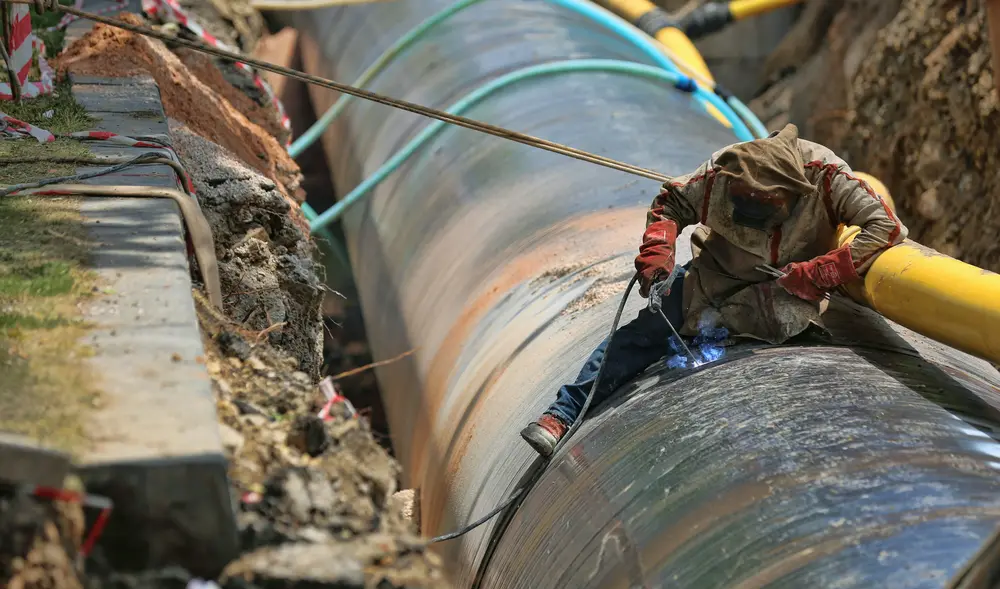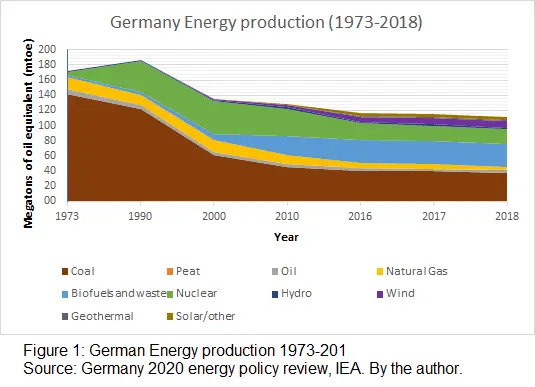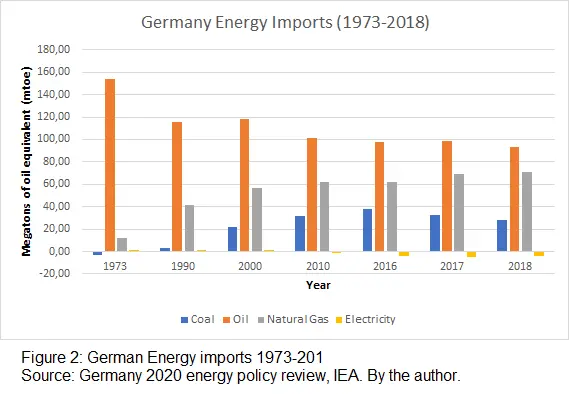Choking on Russian gas: the problems that Nord Stream II poses for Germany

The EU has committed to become an example of a low-carbon economy, as it is clear by the initiative of the EU Green Deal (European Commission, n.d.). Germany is one of the countries that are at the forefront bloc’s environmental initiatives (Goldthau, 2016, page 12) as shown in its commitment to make the economy carbon-neutral, phase out coal and nuclear as energy sources, and make the country more reliant on domestic, renewable energy by 2050. This set of policy goals is known as the Energy transition or Energiewende and, to achieve them, Germany has divested itself of its main domestic sources of energy production: coal and nuclear power. Germany's energy production from 1990 to 2018, measured in megatons of oil equivalent (mtoe), has declined for all types except renewables such as solar, wind, and geothermal (IEA, 2020, page 215) as seen in Figure 1. This is mainly due to the phase-out of nuclear and coal-fired power plants, with nuclear expected to be phased out by 2022 and coal by the end of the 2030s at latest (Edwardes-Evans, 2020).
Since the economy and the country cannot function without energy, imports of other energy sources—in this case, natural gas— have become increasingly relevant, particularly since 2017 (IEA, 2020, page 215).
The German government's goal is to increase the share of renewable energy in total energy consumption to 30% by 2030 (IEA, 2020, page 90). Nevertheless, this requires first overcoming technological and infrastructure barriers in storage and transport. Most of Germany's renewable generation capacity is located in the north of the country, but there are insufficient electricity grids to connect green energy to industrial centers in the south and west of Germany (IEA, 2020, page 95).
As a short-term strategy, the federal government has turned to gas as a "transitional energy" while these obstacles are overcome (Wettengel, 2018) and, in this regard, no initiative has received as much attention as Nord Stream II, a construction project to expand gas transport infrastructure from Russia to Germany through the Baltic Sea. The construction, announced in 2015 and started in 2018, would increase delivery capacity from Russia to Germany by 55 billion cubic meters (bcm) per year, providing Germany low gas prices and the opportunity to become the main transit state for Russian gas to the EU and thus an energy hub for the region (EWI, 2016; Goldthau, 2016).
Nevertheless, the Nord Stream II’s possible benefits are clearly outweigh by the problems it could create to the environment, to Germany’s image towards its main allies, and to the country’s long-term decarbonization goals.
To begin with, according to experts such as the environmental Think Tank EG, Germany does not need more gas import capacity. Three pipelines already connect Germany with Russia that account for 98 bcm in import capacity (IEA, 2020, page 153). In addition, Germany has access to around 54 bcm of import capacity within the EU from Norway and additional pipelines connecting Dutch gas fields to Germany (IEA, 2020, page 153). According to a forecast from Rystad Energy (2020), German demand will peak in 2034 at 110 bcm and start to decline from that point onwards. The previously mentioned pipelines could deliver over 150 bcm without Nord Stream II, far above the expected peak demand.
Added to that the country has pipelines connected to LNG terminals with spare capacity in Belgium (Zeebrugge), France (Dunkirk) and the Netherlands (Rotterdam) (IEA, 2020, pages 154-5), and the German government has made investment plans to build three LNG import terminals in the cities of Brunsbuettel, Stade and Wilhelmshaven (IEA, 2020, pages 154-5). It is clear then, that in terms of securing gas supply, Nord Stream II is not particularly necessary.
Some have highlighted how this pipeline will secure lower gas prices for the country, making Germans pay less to consume gas. This, though it might seem beneficial in economic terms, does not assess the environmental impact of the gas Germany will consume. According to international law firm ClientEarth in a lawsuit against Nord Stream II, the gas that will come through the pipeline will produce about 106 million tons of CO2 when burned (Istrate, 2019), not to mention the environmental impact of this gas in Russia during the extraction and transportation process. Furthermore, methane leaks from pipelines - although less likely with new pipelines such as Nord Stream II - are still an environmental hazard over 70 times more damaging than CO2. It means that if even 3.5% of the gas leaks, the pipeline would be as damaging to the environment as coal (Istrate, 2019).
Experts point out that Nord Stream II could even be detrimental to the plan of making the economy greener in the long run, as such a large investment in infrastructure would "tie" Germany to gas for a decade (Wettengel, 2018).
Finally, the German government’s image at the glance of its allies has been negatively affected by supporting the project. Countries like France and the US have heavily criticized the construction of Nord Stream II. While Western Europe is skeptical of increasing ties with an authoritarian state like Putin's Russia, especially after the events involving Russian opposition leader Alex Navalny (DW, 2021), the United States is more vocal about how this infrastructure could increase dependence on Russian gas (Wesolowsky, 2021) and debilitate EU's political position against Moscow.
Studies such as Goldthau (2016) have shown there is little to no possibility of the EU becoming effectively dependent on Russian gas, since the gas market is becoming more and more dynamic, and it is becoming harder for suppliers to abuse their market power. However, it does not mean that allies are not discontent with the German position, and that it does goes against the foreign policy of its major allies.
Thus, with regard to Nord Stream II, not only is its necessity doubted, but it also creates several problems for German environmental policy and distrust among allies. So the question is what to do with Nord Stream II? Is it possible to simply stop and cancel the project?
Possible? Yes, but rather difficult. The project has cost over 9 billion euros and is as good as finished - it is less than 200 km of construction work away from completion (Wesolowsky, 2021). Cancelling Nord Stream II would not only mean a big loss for all private companies involved in the project, but also a major blow to the already delicate German-Russian relations. The German government needs to develop a strategy to counter the threat to environmental objectives posed by Nord Stream II. Either a drastic and outward-looking solution or a subtle and inward-looking one, this debate must be held before the pipeline comes on stream, if it ever does.

About the author
Jesus Renzullo is a first year MPP student at the Willy Brandt School, specializing in Socio-economic Development Policies and Conflict Studies and Management. He holds a bachelor’s degree in International Affairs from the Central University of Venezuela (UCV) and has worked since 2018 in the Venezuelan Think Tank Cedice Libertad, writing on the topics of Venezuelan international trade and new-age technologies. He has also worked as lecturer for the Central University of Venezuela and as exports advisor for the private sector.
~ The views represented in this blog post do not necessarily represent those of the Brandt School. ~

